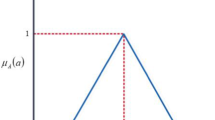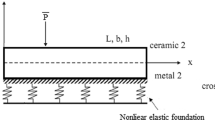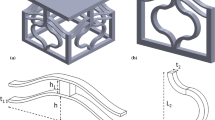Abstract
We did a comparative study of shear coefficients in free vibration analysis of curved beams having circular and rectangular crosssections. Until recently, the shear coefficient k in Timoshenko beam theory has been studied by many researchers to include transverse shear deformation effect. To obtain more reliable numerical results, a higher-order hybrid-mixed curved beam element is formulated and programmed in MATLAB. The present numerical experiments show that k = 6(1 + v)2 / (7 + 12v + 4v 2) is the best expression both for circular and rectangular cross-sections in the flexural vibration of curved beams.
Similar content being viewed by others
References
S. P. Timoshenko, On the correction for shear of the differential equation for transverse vibrations of prismatic bars, Philosophical Magazine, 41 (1921) 744–746.
S. P. Timoshenko, On the transverse vibrations of bars of uniform cross-section, Philosophical Magazine, 41 (1922) 125–131.
T. Kaneko, On Timoshenko’s correction for shear in vibrating beams, Journal of Physics D, 8 (1975) 1927–1936.
H. E. Rosinger and I. G. Ritchie, On Timoshenko’s correction for shear in vibrating isotropic beams, Journal of Physics D, 10 (1977) 1461–1466.
G. R. Cowper, The shear coefficient in Timoshenko’s beam theory, Journal of Applied Mechanics, 33 (1966) 335–340.
N. G. Stephen and M. Levinson, A second order beam theory, Journal of Sound and Vibration, 67 (1979) 293–305.
N. G. Stephen, Timoshenko’s shear coefficient from a beam subjected to gravity loading, ASME Journal of Applied Mechanics, 47 (1980) 121–127.
J. R. Hutchinson and S. D. Zilmer, On the transverse vibration of beams of rectangular cross-section, ASME Journal of Applied Mechanics, 53 (1986) 39–44.
P. F. Pai and M. J. Schulz, Shear correction factors and an energy-consistent beam theory, International Journal of Solids and Structures, 36 (1999) 1523–1540.
J. R. Hutchinson, Shear coefficients for Timoshenko beam theory, ASME Journal of Applied Mechanics, 68 (2001) 87–92.
S. Puchegger, S. Bauer, D. Loidl, K. Kromp and H. Peterlik, Experimental validation of the shear correction factor, Journal of Sound and Vibration, 261 (2003) 177–184.
K. T. Chan, K. F. Lai, N. G. Stephen and K. Young, A new method to determine the shear coefficient of Timoshenko beam theory, Journal of Sound and Vibration, 330 (2011) 3488–3497.
J. G. Kim and Y. K. Park, The effect of additional equilibrium stress functions on the three-node hybrid-mixed curved beam element, Journal of Mechanical Science and Technology, 22 (2008) 2030–2037.
A. F. Saleeb and T. Y. Chang, On the hybrid-mixed C0 curved beam elements, Computer Methods in Applied Mechanics and Engineering, 60 (1987) 95–121.
R. J. Roark, Formulas for stress and strain, McGraw-Hill, New York (1938).
R. D. Mindlin and H. Deresiewicz, Thickness-shear and flexural vibrations of a circular disk, Journal of Applied Physics, 25 (1954) 1329–1332.
Y. Tanji, H. Moriya, Y. Shirakawa and O. Tamate, Evaluation of precise measurements of Young’s modulus and shear modulus by the electro-static driving method, Journal of the Japanese Institute of Metals, 36 (1972) 368–373.
J. D. Renton, A note on the form of the shear coefficient, International Journal of Solids and Structures, 34 (1996) 1681–1685.
R. E. Rossi and P. A. A. Laura, Dynamic stiffening of an arch clamped at one end and free at the other, Journal of Sound and Vibration, 160 (1993) 190–192.
Author information
Authors and Affiliations
Corresponding author
Additional information
Recommended by Associate Editor Heung Soo Kim
Jin-Gon Kim received the B.S. degree in Mechanical Engineering from Seoul National University in 1991. His M.S. degree and Ph.D. are from Seoul National University in 1993 and 1998, respectively. Dr. Kim is currently a professor in the School of Mechanical and Automotive Engineering of Catholic University of Daegu in Korea. His research areas are computational mechanics, biomechanics and optimal design.
Rights and permissions
About this article
Cite this article
Kim, JG., Lee, JK. & Yoon, H.J. On the effect of shear coefficients in free vibration analysis of curved beams. J Mech Sci Technol 28, 3181–3187 (2014). https://doi.org/10.1007/s12206-014-0727-9
Received:
Revised:
Accepted:
Published:
Issue Date:
DOI: https://doi.org/10.1007/s12206-014-0727-9




